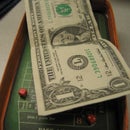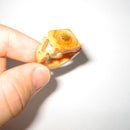Introduction: Build a Profesional Style Screen Printing Table
Well now that's it's 2010 I figured I should make a new instructable, so here we go....
The following is the steps I used to build a production quality screen printing table with a built in developing station for the screens. A few of the major pieces are either things I had around, or things that I found. I hope to give you an idea of how to build your own, but keep in mind that I may not be able to give you very good options for some of the supplies.
Step 1: Materials and Such.
The base for this table is actually another table. It was an old display table from a retail store that we had been using as a dining room table, but slowly became a work table. The top had gotten really beat and I never felt like refinishing it. Now, I don't have to because it's got a whole new top. Yay! Anyway, materials in list form:
1 table (if you skipped the words up above this probably sounds dumb)
2 sheets of 1/2 inch MDF
1 sheet 1/4 inch MDF
4 sections of 4x4 cut to the height of the base table
3-4 UV lights with fixtures
2 mending brackets
1 roll of 1/2 inch industrial felt in the size of the table you want to build
1 roll of raw canvas long enough and wide enough to cover table
Black out cloth
Staple gun and staples
Glue gun
Screws, nails, etc.
Paint brush
White glue
Water
Small bucket or something, maybe a bowl, or deep saucer... you know, a vessel of some sort.
twill tape
Maybe a little frilly trim if you're into it
* The felt came from a school that was recovering all of their screen printing tables, and was going to throw it away. Apparently, they do it every few years, so I would recommend asking around at your local art school to see if they do the same thing. I'm sure you could buy this somewhere, probably online.
Step 2: Table Top.
The roll of felt we got was 4'x10', so in order to accommodate it we decided to build the table 4'x10'. So to start I had two pieces of 1/2" MDF cut down to 4'x5' . I wanted to keep the seem right in the center, so that there was no bowing on either end.
Next I placed one of the pieces on the table and measured in the corners for leg placement. I pre-drilled and counter sunk the holes for the legs. Keep in mind that you want this table top to be as smooth possible, so make sure the screw heads will go down deep enough, but not so deep that they have nothing to hold on to.
Then measured out the legs on the other half and attached them.
Finally I squared up the two halves and joined them together with mending brackets.
Step 3: Developing Area
Using the existing table legs, some UV lights and some black out cloth, we can burn our screens right in the table, isn't that great!?!
I cut the 1/4" MDF into the largest size I could fit under the table without it sticking out and ruining my shins. It sits on top of the metal leg support from the base table.
I mounted the UV light fixtures on the underside of the base table, keeping them as evenly spaced as possible for an even exposure.
We had black out cloth laying around that we had used for test prints a while ago (which is why they are covered in random images) And wrapped it 80% of the way around the base table. Using the twill tape, and a staple gun, it's attached directly to the edge of the base table's top. The twill tape give it extra support so it doesn't rip off the staples.
The front portion was left open (the missing 20%) so that we could use another piece of black out cloth to make an over-lapping panel that acts as a access panel. Apparently the twill tape and staples wasn't attractive enough, so "we" decided to hot glue a lovely piece of trim all the way around. It looks nice and all I suppose, but it would have never occurred to me to cover up something that you barely see, but well, whatever, "we're" happy with it now so...
Step 4: The New Table Top.
First I sealed the MDF with a mixture of white glue and water. This isn't super necessary, but MDF has a tendency to bubble when it gets wet, and screen printing can be a wet business sometimes. So slap on a couple of coats and then let it dry before putting down the felt.
The felt is easy, just roll it on and square it up. The canvas will hold it in place, and it's also got enough weight and surface area that it won't really slip at all.
Next I laid out the canvas and cut to size in place, I left enough overlap to be able to pull it tight and staple it to the underside of the MDF. Before stapling, the canvas is ironed right on top of the table with a little steam to get out all the creases and wrinkles. You want this as smooth as possible. When stapling, do one short side, pull it tight to the other short side, then do one of the long sides. This will let you pull the other short an long sides real nice and tight, which is what you want. Cut off any extra canvas just for clean finished look.
Step 5: Finishing Up.
I couldn't find pictures, but I cut down two pieces of finished fiberboard to lay across the top so that there's a nice surface to work on when we're not printing. If I get around to taking new pictures or find the old ones I'll put them up. For a future addition I'll probably put a metal rail down one side for registration purposes, but since I haven't done it, there's no pictures.
Happy printing!













